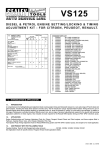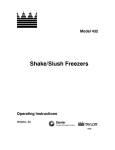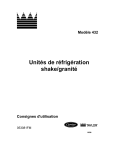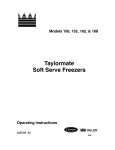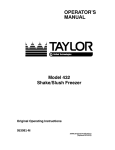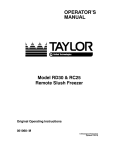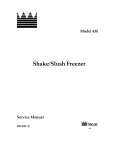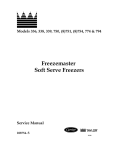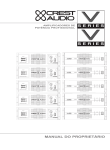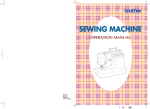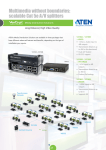Download Taylor SLUSH 382 User's Manual
Transcript
Model 382 (With RC25) Slush Freezer Operator’s Manual 053105- M 10/98 Complete this page for quick reference when service is required: Taylor Distributor: Address: Phone: Service: Parts: Date of Installation: Information found on the 382 data label: Model Number: Serial Number: Electrical Specs: Voltage Cycle Phase Maximum Fuse Size: Amps Minimum Wire Ampacity: Amps Part Number: Information found on RC25 data label: Model Number: Serial Number: Electrical Specs: Voltage Cycle Phase Maximum Fuse Size: Amps Minimum Wire Ampacity: Amps E October, 1998 Taylor All rights reserved. 053105--M The word Taylor and the Crown design are registered trademarks in the United States of America and certain other countries. Taylor Company 750 N. Blackhawk Blvd. Rockton, IL 61072 Table of Contents Section 1 To the Installer . . . . . . . . . . . . . . . . . . . . . . . . . . . . . . . . . . . . . . . . . . . . Installation Instructions . . . . . . . . . . . . . . . . . . . . . . . . . . . . . . . . . . . . . . . . . . . . . . . . . Electrical Connections . . . . . . . . . . . . . . . . . . . . . . . . . . . . . . . . . . . . . . . . . . . . . . . . . Section 2 To the Operator . . . . . . . . . . . . . . . . . . . . . . . . . . . . . . . . . . . . . . . . . . . Compressor Warranty Disclaimer . . . . . . . . . . . . . . . . . . . . . . . . . . . . . . . . . . . . . . . Section 3 Safety . . . . . . . . . . . . . . . . . . . . . . . . . . . . . . . . . . . . . . . . . . . . . . . . . . . . Section 4 Operator Parts Identification . . . . . . . . . . . . . . . . . . . . . . . . . . . . . . . Beater Door Assembly . . . . . . . . . . . . . . . . . . . . . . . . . . . . . . . . . . . . . . . . . . . . . . . . . Accessories . . . . . . . . . . . . . . . . . . . . . . . . . . . . . . . . . . . . . . . . . . . . . . . . . . . . . . . . . . Section 5 Important: To the Operator . . . . . . . . . . . . . . . . . . . . . . . . . . . . . . . . . Symbol Legend . . . . . . . . . . . . . . . . . . . . . . . . . . . . . . . . . . . . . . . . . . . . . . . . . . . . . . . Control Switch (Item 1) . . . . . . . . . . . . . . . . . . . . . . . . . . . . . . . . . . . . . . . . . . . . . . . . . Fill Switch (Item 2) . . . . . . . . . . . . . . . . . . . . . . . . . . . . . . . . . . . . . . . . . . . . . . . . . . . . Add Mix Light (Item 3) . . . . . . . . . . . . . . . . . . . . . . . . . . . . . . . . . . . . . . . . . . . . . . . . . Mix Out Light (Item 4) . . . . . . . . . . . . . . . . . . . . . . . . . . . . . . . . . . . . . . . . . . . . . . . . . . Viscosity Control (Item 5) . . . . . . . . . . . . . . . . . . . . . . . . . . . . . . . . . . . . . . . . . . . . . . . Standby Switch (Optional) . . . . . . . . . . . . . . . . . . . . . . . . . . . . . . . . . . . . . . . . . . . . . . Display Light Switch (Item 6) (Optional) . . . . . . . . . . . . . . . . . . . . . . . . . . . . . . . . . . Push-Button Switch . . . . . . . . . . . . . . . . . . . . . . . . . . . . . . . . . . . . . . . . . . . . . . . . . . . . Section 6 Operating Procedures . . . . . . . . . . . . . . . . . . . . . . . . . . . . . . . . . . . . . Assembly . . . . . . . . . . . . . . . . . . . . . . . . . . . . . . . . . . . . . . . . . . . . . . . . . . . . . . . . . . . . Sanitizing . . . . . . . . . . . . . . . . . . . . . . . . . . . . . . . . . . . . . . . . . . . . . . . . . . . . . . . . . . . . Priming . . . . . . . . . . . . . . . . . . . . . . . . . . . . . . . . . . . . . . . . . . . . . . . . . . . . . . . . . . . . . . Closing Procedure . . . . . . . . . . . . . . . . . . . . . . . . . . . . . . . . . . . . . . . . . . . . . . . . . . . . Draining Product From The Freezing Cylinder . . . . . . . . . . . . . . . . . . . . . . . . . . . . Rinsing . . . . . . . . . . . . . . . . . . . . . . . . . . . . . . . . . . . . . . . . . . . . . . . . . . . . . . . . . . . . . . Cleaning . . . . . . . . . . . . . . . . . . . . . . . . . . . . . . . . . . . . . . . . . . . . . . . . . . . . . . . . . . . . . Disassembly . . . . . . . . . . . . . . . . . . . . . . . . . . . . . . . . . . . . . . . . . . . . . . . . . . . . . . . . . . Brush Cleaning . . . . . . . . . . . . . . . . . . . . . . . . . . . . . . . . . . . . . . . . . . . . . . . . . . . . . . . Table of Contents 1 1 1 5 5 6 7 8 9 10 10 10 11 11 11 11 11 11 11 12 12 16 17 18 18 18 19 20 20 Models 382RC25 Table of Contents -- Page 2 Section 7 Important: Operator Checklist . . . . . . . . . . . . . . . . . . . . . . . . . . . . . . During Cleaning and Sanitizing . . . . . . . . . . . . . . . . . . . . . . . . . . . . . . . . . . . . . . . . . Troubleshooting Bacterial Count . . . . . . . . . . . . . . . . . . . . . . . . . . . . . . . . . . . . . . . . Regular Maintenance Checks . . . . . . . . . . . . . . . . . . . . . . . . . . . . . . . . . . . . . . . . . . . Winter Storage . . . . . . . . . . . . . . . . . . . . . . . . . . . . . . . . . . . . . . . . . . . . . . . . . . . . . . . . Section 8 Troubleshooting Guide . . . . . . . . . . . . . . . . . . . . . . . . . . . . . . . . . . . . Section 9 Parts Replacement Schedule . . . . . . . . . . . . . . . . . . . . . . . . . . . . . . . Section 10 Parts List . . . . . . . . . . . . . . . . . . . . . . . . . . . . . . . . . . . . . . . . . . . . . . . . . Wiring Diagrams . . . . . . . . . . . . . . . . . . . . . . . . . . . . . . . . . . . . . . . . . . . . . . . . . . . . . . 21 21 21 21 21 22 25 26 32 Note: Continuing research results in steady improvements; therefore, information in this manual is subject to change without notice. Models 382/RC25 Table of Contents Section 1 To the Installer Stationary appliances which are not equipped with a power cord and a plug or other device to disconnect the appliance from the power source must have an all--pole disconnecting device with a contact gap of at least 3 mm installed in the external installation. This machine is designed for indoor use only. DO NOT install the machine in an area where a water jet could be used to clean or rinse the machine. Failure to follow this instruction may result in serious electrical shock. CAUTION: THIS EQUIPMENT MUST BE PROPERLY GROUNDED! FAILURE TO DO SO CAN RESULT IN SEVERE PERSONAL INJURY FROM ELECTRICAL SHOCK! Installation Instructions Preparation Beater rotation must be counterclockwise as viewed looking into the freezing cylinder of the Model 382 dispenser. Uncrate the condensing and dispensing units. After inspecting both units for damage, position them in the desired locations. Electrical Connections NOTE: The following procedures should be performed by a trained service technician. Individual power supplies are required for each unit. Check the data label on each unit for fuse, circuit ampacity, and electrical specifications. For proper power connections, refer to the wiring diagram provided inside of the electrical box. To correct rotation on a three-phase unit, exchange any two incoming power supply lines at the freezer main terminal block only. In the United States, this equipment is intended to be installed in accordance with the National Electrical Code (NEC), ANSI/NFPA 70--1987. The purpose of the NEC code is the practical safeguarding of persons and property from hazards arising from the use of electricity. This code contains provisions considered necessary for safety. Compliance therewith and proper maintenance will result in an installation essentially free from hazard! To correct rotation on a single-phase unit, exchange the leads inside the beater motor. (Follow the diagram printed on the motor.) Electrical connections are made directly to the splice box. The splice box is located behind the back panel. IMPORTANT Beater rotation on the 380 Series differs from other Taylor equipment. In all other areas of the world, equipment should be installed in accordance with the existing local codes. Please contact your local authorities. 050722 Models 382/RC25 1 To the Installer Refrigeration Charging and Line Construction Note: Maximum line length is 150 ft. (45.7 m). Note: To meet individual installation requirements, lines must be purchased and constructed locally. The dispensing unit is shipped with a refrigerant holding charge that is sufficient enough to prevent moisture contamination (8 oz./227 g. HP62). This holding charge will become part of the total system charge. Line Size Liquid Line - Single or dual dispensers require 3/8” refrigerant grade copper tubing (hard or soft). The condensing unit is shipped with the total amount of refrigerant required for a typical installation of 75 ft. or less with a single dispenser. For other installation configurations, use the following chart for line sizing and for adding required refrigerant. Note: Insulating the liquid line is recommended if it is exposed to high ambient conditions. This will reduce heat accumulation and prevent the formation of flash gas in the liquid line. Recommended System Refrigerant Charge Suction Line - Less than 75 ft. (22.8 m) total line length requires 5/8” refrigerant grade copper tubing (hard or soft). Maximum 5/8” tubing length is 75 ft. (22.8 m). Single Dispensing Installations Domestic Suction Line Length Dispenser Note: Suction lines must be insulated. Required Charge Less than 75 ft. Single 10 lb. More than 75 ft. Single 12 lb. (add 2 lb.) Less than 75 ft. Dual 13 lb. (add 3 lb.) More than 75 ft. Dual 15 lb. (add 5 lb.) Suction Line - More than 75 ft. (22.8 m) total line length requires 3/4” refrigerant grade copper tubing (hard or soft). Maximum tubing length is 150 ft. (45.7 m). Dual Dispensing Installations (One Condenser, Two Dispensers) International Suction Line Length Dispenser Individual Suction Line - Requires 5/8” refrigeration grade copper tubing (hard or soft) from each dispenser to the common suction tube. Required Charge Less than 22.8 m Single 4.5 kg More than 22.8 m Single 5.4 kg (add 0.91 kg) Less than 22.8 m Dual 5.9 kg (add 1.4 kg) More than 22.8 m Dual 6.8 kg (add 2.3 kg) Common Suction Line - Requires 3/4” refrigeration grade copper tubing. Note: Lines must be insulated and requires a 5/8” x 3/4” reducer fitting at the quick disconnect connections. See Figure 1 below. Note: Use 5/8” wire to attach the quick disconnects to the other components. Figure 1 To the Installer 2 Models 382/RC25 DISPENSER UNIT 382 Condenser Access Valve Compressor Liquid Refrigerant Reciever CONDENSING UNIT DISPENSER UNIT 382 Note: 5/8” individual line lengths are not to exceed 75 ft. (22.8 m) maximum length each. Total line length is not to exceed 150 ft. (45.7 m). 5/8” line + 5/8” line + 3/4” line = 150 ft. or less. Figure 2 Installation Normally, any straight run of tubing must be supported near each end of the run. Long runs require additional supports. As a guide, 3/8” to 3/4” copper should be supported every 5 ft. (1.5 m). When changing directions, no corner should be left unsupported. Supports should be placed a maximum of 2 ft. (.61 m) in each direction from the corner. If soft copper tube is used, make sure it is not kinked or flattened. If hard drawn copper tubing is used, use only long radius elbows. Step 1 Install refrigeration lines from the dispenser to the condensing unit. Do not create oil traps. Note: For proper oil return, installation of horizontal suction lines are to be sloped downward in the direction of the condensing unit. The slope must be a minimum 1/4” (6.4 mm) angle per 10 ft. (30.48 mm) of line length. FROM DISPENSER Step 2 Braze the supplied quick connect/disconnect couplings on the dispenser end of the refrigeration lines. Couplings are supplied with the dispenser. Step 3 Braze the quick connect/disconnect couplings and access tees on the condensing unit end of the refrigeration lines. Couplings and access tees are supplied with the unit. 10'-0" (3.048 m) FLOW ¼" (.64 cm) TO CONDENSER Note: Wrap a wet cloth around the brass coupling bodies to prevent heat damage to the seal. Step 4 Test the field constructed lines for leaks. Figure 3 Models 382/RC25 3 To the Installer Step 6 Check all connections for leaks. Step 5 Evacuate the field constructed refrigerant lines using the access fittings brazed on the condensing end of the refrigeration lines. Step 7 Insulate all exposed suction line tubing and fittings. Step 6 When the evacuation process is complete, relieve the vacuum with 4 oz. (113 g.) of HP62 refrigerant per line, for a total of 8 oz. (227 g.) This procedure will prevent moisture contamination during dispenser and condensing unit connection and complete the total charge. Step 8 Set the pump down switch located in the condensing unit. For indoor condensing unit application: Set cut in at 30 PSIG (207 kPa). Set cut out at 5 PSIG (34 kPa). For outdoor condensing unit application: Refrigeration Connections Set cut in at 20 PSIG (138 kPa). Set cut out at 0 PSIG (0 kPa). Connect the refrigerant line quick connect/disconnect couplings to the mating quick connect/disconnect couplings on the dispensing and condensing unit. Pump down pressure readings are to be taken at the refrigeration line access fittings at the condensing unit. Step 1 Remove the shipping caps from the quick connect/disconnect coupling on the dispensing unit. Step 9 Allow the dispenser to run until the condensing unit cycles off. Verify the proper pump down pressure switch setting. See Step 8 of “Refrigeration Connections” (page 4). Step 2 Thoroughly clean and lubricate the mating surfaces of the quick connect/disconnects. Note: Pump down pressure readings are to be taken at the refrigeration line access fittings near the condensing unit. Note: Use polyolester oil to lubricate the surfaces. Step 3 Manually thread the coupling halves together to insure proper mating of the threads. Step 10 If necessary, adjust viscosity to produce satisfactory product. Adjustments are made by turning the viscosity adjustment screw (located under the control panel) clockwise for a thicker product or counterclockwise for a thinner product. Step 4 Using proper sized wrenches, tighten the coupling halves until the round, flat surfaces of inner coupling bodies completely depress one another. Step 5 Once the flat surfaces are completely depressed, tighten the couplings an additional 1/4 turn. This step is necessary to insure that the knife edge of the seal seats into the brass seat of the coupling halves, forming a leak-proof joint (metal seal). Set Up Procedures Standard Fill Module Step 1 Connect the product supply line to the 1/4” barbed fitting on the fill solenoid. Adjust the fill system pressure to deliver product to the hopper at approximately 15 to 20 PSIG (103-138 kPa). Step 2 Lubricate, assemble, sanitize and prime the dispenser as outlined in the Assembly section of this manual. Step 3 Place the power switch in the “AUTO” position. Note: The fill switch must be in the “ON” position to enable refrigeration. Figure 4 To the Installer 4 Models 382/RC25 Section 2 To the Operator Compressor Warranty Disclaimer The freezer you have purchased has been carefully engineered and manufactured to give you dependable operation. The Taylor equipment, when properly operated and cared for, will produce a consistent quality product. Like all mechanical products, this machine will require cleaning and maintenance. A minimum amount of care and attention is necessary if the operating procedures outlined in this manual are followed closely. The refrigeration compressor(s) on this machine are warranted for the term indicated on the warranty card accompanying this machine. However, due to the Montreal Protocol and the U.S. Clean Air Act Amendments of 1990, many new refrigerants are being tested and developed, thus seeking their way into the service industry. Some of these new refrigerants are being advertised as drop-in replacements for numerous applications. It should be noted that, in the event of ordinary service to this machine’s refrigeration system, only the refrigerant specified on the affixed data label should be used. The unauthorized use of alternate refrigerants will void your compressor warranty. It will be the owner’s responsibility to make this fact known to any technician he employs. This Operator’s Manual should be read before operating or performing any maintenance on your equipment. Your Model 382 will NOT eventually compensate and correct for any errors during the set-up or filling operations. Thus, the initial assembly and priming procedures are of extreme importance. It is strongly recommended that all personnel responsible for the equipment’s operation thoroughly read this manual. It should also be noted that Taylor does not warrant the refrigerant used in its equipment. For example, if the refrigerant is lost during the course of ordinary service to this machine, Taylor has no obligation to either supply or provide its replacement either at billable or unbillable terms. Taylor does have the obligation to recommend a suitable replacement if the original refrigerant is banned, obsoleted, or no longer available during the five year warranty of the compressor. If you require technical assistance, please contact your local authorized Taylor Distributor. If the crossed out wheeled bin symbol is affixed to this product, it signifies that this product is compliant with the EU Directive as well as other similar legislation in effect after August 13, 2005. Therefore, it must be collected separately after its use is completed, and cannot be disposed as unsorted municipal waste. The Taylor Company will continue to monitor the industry and test new alternates as they are being developed. Should a new alternate prove, through our testing, that it would be accepted as a drop-in replacement, then the above disclaimer would become null and void. To find out the current status of an alternate refrigerant as it relates to your compressor warranty, call the local Taylor Distributor or the Taylor Factory. Be prepared to provide the Model/Serial Number of the unit in question. The user is responsible for returning the product to the appropriate collection facility, as specified by your local code. For additional information regarding applicable local laws, please contact the municipal facility and/or local distributor. 050906 Models 382/RC25 5 To the Operator Section 3 Safety We at Taylor Company are concerned about the safety of the operator when he or she comes in contact with the freezer and its parts. Taylor has gone to extreme efforts to design and manufacture built-in safety features to protect both you and the service technician. As an example, warning labels have been attached to the freezer to further point out safety precautions to the operator. DO NOT allow untrained personnel to operate this machine. S DO NOT operate the freezer unless all service panels and access doors are restrained with screws. S DO NOT remove the door, beater, scraper blades, drive shaft, or torque rotor shaft unless the power switch is in the OFF position. S DO NOT put objects or fingers in the door spout. Failure to follow these instructions may result in contaminated product or severe personal injury to fingers or hands from hazardous moving parts. S IMPORTANT -- Failure to adhere to the following safety precautions may result in severe personal injury. Failure to comply with these warnings may damage the machine and its components. Component damage will result in part replacement expense and service repair expense. To Operate Safely: USE EXTREME CAUTION when removing the beater assembly. The scraper blades are very sharp and may cause injury. DO NOT operate the freezer without reading this operator’s manual. Failure to follow this instruction may result in equipment damage, poor freezer performance, health hazards, or personal injury. This freezer must be placed on a level surface. Failure to comply may result in personal injury or equipment damage. DO NOT operate the freezer unless it is properly grounded. S DO NOT attempt any repairs unless the main power supply to the freezer has been disconnected. S DO NOT operate the freezer with larger fuses than specified on the freezer data label. Failure to follow these instructions may result in electrocution or damage to the machine. Contact your local authorized Taylor Distributor for service. S DO NOT obstruct air intake and discharge openings: 6” (152 mm) minimum air space on sides and rear, 7-1/2” (191 mm) minimum on bottom. Failure to follow this instruction may cause poor freezer performance and damage to the machine. This freezer is designed to operate indoors, under normal ambient temperatures of 70_--75_F (21_--24_C). The freezer has successfully performed in high ambient temperatures of 104_F (40_C) at reduced capacities. NOISE LEVEL: Airborne noise emission does not exceed 78 dB(A) when measured at a distance of 1.0 meter from the surface of the machine and at a height of 1.6 meters from the floor. DO NOT use a water jet to clean or rinse the freezer. Failure to follow this instruction may result in serious electrical shock. 050722 Safety 6 Models 382/RC25 Section 4 Item Description Operator Parts Identification Part No. Item 1 REMOTE CONDENSING UNIT RC 25 2 PANEL--SIDE LEFT 052117 3 COVER--HOPPER--12 QT 045416 4 PANEL A.--REAR X52115 10 5 PANEL--SIDE RIGHT 051713 6 GASKET--BASE PAN 051868 7 TRAY A.--DRIP X46848 Models 382/RC25 8 Part No. SHIELD--SPLASH 046851 DECAL--DEC--380--FLAVOR SET OF 4 050703 DECAL--DEC--TAYLOR 045967 PANEL--FRONT 051090 11 STUD--FREEZER DOOR 051950 12 SHELF--DRIP TRAY 052065 9 7 Description Operator Parts Identification Beater Door Assembly Item Description Part No. Item Description Part No. 1 KNOB--DRAW VALVE--BLACK 047358 13 ARM--TORQUE 014500 2 SCREW--1/4--20X9/16 THUMB--300 047632 14 O--RING--.291 ID X .080W 018550 3 PLATE--DRAW SPOUT MOUNT 049275 15 TORQUE A. X51081 4 SPOUT--DOOR ZERO WASTE 049276--BLA 16 BEARING--GUIDE 014496 5 O--RING--2.375 OD X 1/16W 046830 17 BEATER A.--TORQUE X51105 6 SPRING--COMP.845X.055X3.5 047357 18 BLADE--SCRAPER 051088 7 VALVE--DRAW 047353 19 CLIP--SCRAPER BLADE 051978 8 STUD--NUT (HANDSCREW) 045644 20 SHAFT--BEATER 049270 9 O--RING--7/8 OD X .103W 014402 21 O--RING--7/8 OD X .139W 025307 10 DOOR A.--PARTIAL X51098 22 SEAL--DRIVE SHAFT 032560 11 O--RING--8--3/8 ODX.105W 027814 23 PLUG--PRIME *380/1* 046833 12 BEARING--FRONT--TORQUE 052005 24 O--RING--9/32 OD X 1/16 WALL 029751 Operator Parts Identification 8 Models 382/RC25 Accessories Item Description Part No. 1 BRUSH--MIX PUMP BODY--3”X7” 023316 2 BRUSH--DRAW VALVE 1”X2”X17” 013073 3 BRUSH--DOUBLE ENDED 013072 4 BRUSH--REAR BRG 1IN.DX2IN.L 013071 5 LUBRICANT--TAYLOR HI PERF--4 048232 6 SANITIZER KAY--5R (CASE OF 125 PACKETS) 041082 Models 382/RC25 9 Operator Parts Identification Section 5 Important: To the Operator 5 2 6 1 ADD MIX MIX OUT Item 1 2 3 4 5 6 3 4 Description Control Switch Fill Switch Add Mix Light Mix Out Light Viscosity Control Display Light Switch (Optional) Symbol Legend Control Switch (Item 1) The control switch is located on the front of the machine. The center position is “OFF”. The up position is the “WASH” mode and activates the beater motor only. The down position is the “AUTO” mode. The “AUTO” mode activates the beater motor and enables refrigeration when the fill switch is in the “ON” position. = The “ON/AUTO” symbol. = The “OFF” symbol. = The “WASH” symbol. = The “ADD MIX” symbol. = The “MIX OUT” symbol. Important: To the Operator 10 Models 382/RC25 Fill Switch (Item 2) Standby Switch (Optional) The fill switch is located under the control channel. The “ON” position enables refrigeration when the control switch is in the “AUTO” position. The “ON” position enables the fill system to replenish and maintain product levels in the freezing cylinder and in the hopper. The “OFF” position terminates the fill function. The refrigeration system is disabled when the fill switch is in the “OFF” position. The standby switch is located under the control channel. To maintain a refrigerated product during long no sale periods, the standby mode will maintain the product at approximately 38_F to 40 _F (3.3_C to 4.4_C). To operate the standby mode, place the power switch in the “AUTO” position. Place the fill switch in the “FILL” position and the standby switch in the “STANDBY” position. To resume normal operation, leave the power switch in the “AUTO” position and the fill switch in the “FILL” position. Move the standby switch to the “OFF” position. Add Mix Light (Item 3) An “ADD MIX” indicating light is located on the front panel. When the light is lit, it indicates that the mix supply in the hopper is low and must be replenished. Display Light Switch (Item 6) (Optional) Mix Out Light (Item 4) The display light switch is located under the control channel. The left position is “OFF”. The right position is “ON”, and activates the display light. A “MIX OUT” indicating light is located on the front panel. When the light is lit, it indicates that the hopper is empty and the mix supply must be replenished. When the indicator lights, refrigeration is automatically disabled to prevent component damage. The beater motor continues to run. Push-Button Switch If an overload condition occurs, the freezer will automatically stop operating. To properly reset the freezer, place the toggle switch in the “OFF” position. Wait two or three minutes; then press the push-button switch. Place the power switch in the “WASH” position and observe the freezer’s performance; place the power switch in the “AUTO” position. Viscosity Control (Item 5) The viscosity adjustment screw is located under the control channel. The viscosity (thickness) of the slush can be adjusted by turning the adjustment screw clockwise for a thicker product or counterclockwise for a thinner product. Models 382/RC25 Note: If the freezer is unplugged from the wall receptacle, it will be necessary to press the push-button switch for the freezer to operate once power is re-established. 11 Important: To the Operator Section 6 Operating Procedures We begin our instructions at the point where the parts are disassembled and laid out to dry from the previous night’s cleaning. Install the drive shaft into the freezing cylinder, hex end first. The drive shaft seal must fit securely over the rear shell bearing. Be certain the drive shaft fits into the drive coupling without binding. The following procedures will explain how to assemble the parts into the freezer, sanitize them, and prime the freezer with fresh product. If you are disassembling the machine for the first time or need information to get to this starting point in our instructions, turn to “Disassembly” on page 20, and start there. Assembly MAKE SURE THE CONTROL SWITCH IS IN THE “OFF” POSITION. Failure to do so may result in personal injury or component damage. Note: When lubricating parts, use an approved food grade lubricant (example: Taylor Lube HP). Every three months discard rubber parts and install new rubber parts. Figure 6 Step 1 Install the beater drive shaft. Lubricate the groove and shaft portion that comes in contact with the rear shell bearing on the beater drive shaft. DO NOT lubricate the hex end of the drive shaft. Step 2 Install the beater assembly. First check scraper blades for any nicks or signs of wear. If any nicks are present or if the blades are worn, replace the blades. Slide the seals over the shaft until they snap into their grooves. Fill the inside portion of the seal with lubricant and evenly lubricate the flat side of the seal that fits onto the rear shell bearing. Figure 5 Operating Procedures Figure 7 12 Models 382/RC25 If the blades are in good condition, assemble the clips on the blades. Install one scraper blade and clip over the two holding pins on one side of the beater. Holding the blade and clip on the beater, turn the assembly over and install the second scraper blade and clip. Figure 10 Insert the torque rotor (guide bearing end first) into the pilot hole in the center of the drive shaft. The hole in the torque rotor shaft should be rotated to the 12 o’clock position. Figure 8 Holding the blades in position, insert the beater assembly into the freezing cylinder, and slide the assembly into position over the drive shaft. Turn the beater slightly to be certain that the beater is properly seated. Figure 11 Step 4 Install the freezer door. Slide the draw valve o-ring into the groove on the draw valve and lubricate the o-ring. Figure 9 When in position, the beater bearing hub will protrude beyond the front of the freezing cylinder about 1/4 inch (.635 cm.). Step 3 Install the torque rotor. Install the plastic guide bearing on the short end of the torque rotor. Slide the o-ring into the groove on the long end of the torque rotor and lubricate the o-ring. Do not lubricate the guide bearing. Models 382/RC25 Figure 12 13 Operating Procedures Align the draw spout assembly with the door. Place the draw spout mounting plate over the draw spout assembly and align the holes. Place the draw valve spring over the shaft end on the draw valve. Figure 13 Figure 16 Insert the draw valve and spring into the door spout until the threaded end of the shaft passes through the hole in the end of the door spout. Thread the draw valve knob onto the end of the draw valve shaft. Using the thumb screws, fasten the draw spout assembly and draw spout mounting plate to the door. Figure 17 Slide the o-ring into the groove on the prime plug. Apply an even coat of lubricant to the o-ring and shaft. Figure 14 Place the door spout seal o-ring into the groove in the door and lubricate the components. Figure 18 Install the prime plug into the bleed port in the top of the freezer door. Do not over-tighten the prime plug. Figure 15 Operating Procedures 14 Models 382/RC25 Step 6 Install the four handscrews on the studs. Finger-tighten the screws equally in a crisscross pattern to insure that the door is snug. Do not over-tighten the handscrews. Figure 19 Place the large o-ring into the groove on the back side of the door and lubricate the installed o-ring. Figure 22 Step 7 Install the torque arm. Position the torque arm by inserting it through the slot in the torque switch arm and down into the hole in the torque rotor which protrudes from the door. Verify proper installation by moving the torque rotor back and forth to be sure it moves freely and easily. Figure 20 Place the door bearing into the back side of the door. Note: Do not lubricate the door bearing. Step 5 Install the freezer door. Align the torque rotor into the center of the door and position the door on the four studs on the front of the freezing cylinder. Firmly push the door into place. Figure 23 Figure 21 Models 382/RC25 15 Operating Procedures Make sure all sanitizer is removed from the fill system. Place the fill switch in the “OFF” position. Step 8 Install the front drip tray and the splash shield under the door spout. Drain any remaining solution from the freezing cylinder. Figure 24 Sanitizing Figure 26 Step 1 Fill System. Disconnect the product supply lines from the mix delivery container. Prepare two gallons (7.6 liters) of an approved 100 PPM sanitizing solution (Example: Kay--5t). USE WARM WATER AND FOLLOW THE MANUFACTURER’S SPECIFICATIONS. Pour the solution into a clean, empty mix delivery container. Step 3 While the solution is flowing through the system, brush clean the mix hopper, the mix inlet hole, and the mix level sensing probe. Step 4 Remove the prime plug and allow all of the solution to flow into the freezing cylinder. Replace the prime plug. Step 5 Place the control switch in the “WASH” position. This will cause the sanitizing solution in the freezing cylinder to be agitated. Allow the solution to agitate for five minutes. Figure 25 Step 2 Connect the container to the mix delivery line. Place the control switch in the “WASH” position. Place the fill switch in the “ON” position. This will activate the mix solenoid. The mix solenoid will remain open until the mix level probe is satisfied. Drain sanitizer from the freezing cylinder and repeat this procedure until the solution is dispensed from the mix delivery container. Operating Procedures Figure 27 16 Models 382/RC25 Step 6 Place the control switch in the “OFF” position. Place an empty mix pail beneath the door spout. Open the draw valve and draw off all of the sanitizing solution. When the sanitizer stops flowing from the door spout, close the draw valve. strength product is flowing from the door spout, close the draw valve. Allow the mix hopper to fill until the product rises to the bleed port. Replace the prime plug. Figure 28 Figure 30 Step 7 Replace the hopper cover. Step 4 Place the control switch in the “AUTO” position. When the unit cycles off, the product will be at serving viscosity. The viscosity (thickness) of the slush can be adjusted by turning the viscosity adjustment screw under the control channel. Turn the viscosity adjustment screw clockwise for a thicker product, or counterclockwise for a thinner product. After making an adjustment, allow the refrigeration system to cycle 2 or 3 times to accurately evaluate the viscosity. Figure 29 Priming Step 1 Connect the mix delivery line to a container filled with mix. Step 2 Remove the prime plug. Figure 31 Step 3 With a mix pail beneath the door spout, open the draw valve. Place the fill switch in the “ON” position to allow fresh product to flow into the freezing cylinder. This will force out any remaining sanitizing solution. When full Models 382/RC25 Note: In order for the refrigeration system to operate, the fill switch must be in the “ON” position while the control switch is in the “AUTO” position. 17 Operating Procedures Closing Procedure Step 2 With a pail beneath the door spout, open the draw valve. When all of the product has been drained from the mix hopper and freezing cylinder, close the draw valve. Make sure the control switch is in the “OFF” position. To disassemble the units, the following items will be needed: S Two cleaning pails S Necessary brushes provided with freezer S Cleaner S Single service towels Draining Product From The Freezing Cylinder Figure 33 Step 1 Place the fill switch in the “OFF” position. Place the control switch in the “WASH” position as far ahead of cleaning time as possible. This will allow frozen product to soften for easier draining. Rinsing Step 1 Remove the hopper cover. Step 2 Pour cool, clean water into the mix hopper and allow it to flow into the freezing cylinder. With the brushes provided, scrub the mix hopper, mix inlet hole, and mix probes. Figure 32 Operating Procedures Figure 34 18 Models 382/RC25 Step 3 Brush clean the mix hopper, the mix inlet hole, and the mix level sensing probes. Step 3 Place the control switch in the “WASH” position. With a mix pail beneath the door spout, open the draw valve. Drain all the rinse water from the freezing cylinder. When the rinse water stops flowing from the door spout, close the draw valve and place the control switch in the “OFF” position. Step 4 Place the control switch in the “WASH” position. This will cause the cleaning solution in the freezing cylinder to be agitated. Allow the solution to agitate for five minutes. Figure 35 Repeat this procedure until the rinse water being drawn from the freezing cylinder is clear. Figure 37 Cleaning Step 5 Place the control switch in the “OFF” position. Place an empty mix pail beneath the door spout. Open the draw valve and draw off all of the cleaning solution. When the solution stops flowing from the door spout, close the draw valve. Step 1 Prepare two gallons (7.6 liters) of an approved cleaning solution (Example: Kay-5t). USE WARM WATER AND FOLLOW THE MANUFACTURER’S SPECIFICATIONS. Step 2 Pour the cleaning solution into the hopper and allow it to flow into the freezing cylinder. Figure 36 Models 382/RC25 Figure 38 19 Operating Procedures Disassembly Note: To remove o-rings, use a single service towel to grasp the o-ring. Apply pressure in an upward direction until the o-ring pops out of its groove. With the other hand, push the top of the o-ring forward and it will roll out of the groove and can be removed easily . BE SURE THE CONTROL SWITCH IS IN THE “OFF” POSITION. Step 3 Thoroughly brush clean all disassembled parts in the cleaning solution making sure all lubricant and mix film is removed. Place all the cleaned parts on a clean dry surface to air dry. Step 1 Remove the torque arm, handscrews, freezer door, beater assembly, scraper blades, torque rotor, and the drive shaft, and take these parts to the sink for cleaning. Step 2 Remove the front drip tray and splash shield and take them to the sink for cleaning. Step 4 Return to the freezer with a small amount of cleaning solution. Brush clean the rear shell bearing with the black bristle brush. Brush Cleaning Step 1 Prepare a sink with an approved cleaning solution. USE WARM WATER AND FOLLOW THE MANUFACTURER’S SPECIFICATIONS. Make sure all brushes provided with the freezer are available for brush cleaning. Step 2 Remove the: S S S S S S S seals from the drive shaft. o-ring and front bearing from the freezer door. door spout from the freezer door. draw valve and spring from the door spout. o-ring from the draw valve. o-ring and guide bearing from the torque rotor. prime plug and prime plug o-ring. Operating Procedures Figure 39 Step 5 Wipe clean all exterior surfaces of the freezer. 20 Models 382/RC25 Section 7 Important: Operator Checklist During Cleaning and Sanitizing Regular Maintenance Checks j 1. Replace scraper blades that are nicked or damaged. ALWAYS FOLLOW LOCAL HEALTH CODES. j 2. Before installing the beater, be certain that the scraper blades are properly attached over the pins. Cleaning and sanitizing schedules are governed by your State or local regulatory agencies and must be followed accordingly. The following check points should be stressed during the cleaning and sanitizing operations. WE RECOMMEND SANITIZING. DAILY CLEANING j 3. Check the rear shell bearing for signs of wear (excessive product leakage from the rear drip pans to the front drip tray). AND j 4. Dispose of o-rings and seals if they are worn, torn, or fit too loosely, and replace with new ones. Troubleshooting Bacterial Count j 5. Follow all lubricating procedures as outlined in “Assembly”. j 1. Thoroughly clean and sanitize the machine regularly, including complete disassembly and brush cleaning. j 6. If your machine is air cooled, check the condenser(s) for accumulation of dirt and lint. Dirty condensers will reduce the efficiency and capacity of the machine. Condensers should be cleaned monthly. Use a soft brush to clean between the fins. Never use screwdrivers or other metal probes to clean between the fins. j 2. Use all brushes supplied for thorough cleaning. The brushes are specially designed to reach all product passageways. j 3. Use the white bristle brush to clean the mix inlet hole which extends from the mix hopper down to the rear of the freezing cylinder. j 4. Use the black bristle brush to thoroughly clean the rear shell bearing located at the rear of the freezing cylinder. Be sure to have a generous amount of cleaning solution on the brush. Winter Storage If the place of business is to be closed during the winter months, it is important to protect the freezer by following certain precautions, particularly if the building is subject to freezing conditions. j 5. Using a screwdriver and cloth towel, keep the female hex drive socket and rear shell bearing clean and free of lubricant and product deposits. j 6. Properly prepare the cleaning and sanitizing solutions. Read and follow label directions carefully. Too strong of a solution may damage the parts and too weak of a solution will not do an adequate job of cleaning or sanitizing. Disconnect the freezer from the main power source to prevent possible electrical damage. j 7. Clean and sanitize the product lines regularly to prevent syrup residue build-up that would restrict the proper flow of syrup. Wrap detachable parts of the freezer such as beater, blades, drive shaft, and freezer door, and place in a protected dry place. Rubber trim parts and gaskets can be protected by wrapping them with moisture-proof paper. All parts should be thoroughly cleaned of dried mix or lubrication which attract mice and other vermin. Your local Taylor Distributor can perform this service for you. j 8. On a regular basis, take a brix reading to assure a consistent, quality product (post mix valve systems only). Models 382/RC25 21 Important: Operator Checklist Section 8 PROBLEM 1. No product is being dispensed with the draw valve open. 2. The product is too thin. 3. The product is too stiff. Troubleshooting Guide Troubleshooting Guide PROBABLE CAUSE REMEDY a. Product freeze-up due to improper product mixing. a. Follow directions for mixing product carefully. -- -- b. The torque arm is not installed. b. Install the torque arm. 15 c. Bent or improperly installed torque rotor. c. Replace the bent rotor or follow proper assembly procedures. 13 a. Improper mixing of product. a. Follow directions for mixing product carefully. -- -- b. Missing, incorrectly installed, or worn scraper blades. b. Replace or install the blades correctly. 12 c. The viscosity adjustment screw needs to be adjusted. c. Adjust the screw accordingly. d. The torque rotor is bound leaving the torque arm in the cold position. Therefore, the compressor will not run. d. Free the torque rotor. -- -- a. The torque rotor bound leaving the torque arm in the warm position. Therefore, the compressor continually runs. a. Free the torque rotor. -- -- b. The torque arm is missing or bent. b. Install or replace the torque arm. 15 c. The viscosity adjustment screw needs to be adjusted. c. Adjust the screw accordingly. d. Improper mixing of product. d. Follow directions for mixing product carefully. 22 PAGE REF. 4, 10 4, 10 -- -- Models 382/RC25 PROBLEM 4. The freezing cylinder walls are scored. 5. Unable to remove the drive shaft. 6. Excessive mix leakage in the rear drip pan. 7. No freezer operation with the unit in the “AUTO” position. Models 382/RC25 PROBABLE CAUSE REMEDY PAGE REF. a. Broken beater pins. a. Repair or replace the beater assembly. -- -- b. The gear unit is out of alignment. b. Contact a service technician. -- -- c. The beater assembly is bent. c. Repair or replace the beater assembly. -- -- d. The door bearing is missing. d. Install the door bearing. 15 a. There is lubrication on the hex end of the drive shaft. a. Do not lubricate the hex end of the drive shaft. Contact a service technician for drive shaft removal. 12 b. Rounded corners of the drive shaft, drive coupling or both components. b. Replace the drive shaft, drive coupling or both components. -- -- a. Improper or inadequate lubrication on the drive shaft o-ring or seal. a. Use the correct lubricant (Taylor Lube) and follow proper lubrication procedures. 12 b. Worn or missing o-ring or seal on the drive shaft. b. Replace rubber parts every 3 months. 12 c. Worn rear shell bearing. c. Contact a service technician for component replacement. -- -- a. The unit is unplugged. a. Plug the power cord in the wall receptacle. -- -- b. The beater motor has tripped the reset mechanism. b. Place the toggle switch in the “OFF” position. Allow the motor to cool, press the reset button and resume normal operation. Contact a service technician if the problem continues. -- -- c. The fill switch is not in the “ON” position. c. Place the fill switch in the “ON” position. 4 d. The circuit breaker tripped or the fuse has blown. d. Reset the circuit breaker or replace the blown fuse. -- -- 23 Troubleshooting Guide PROBLEM 8. The unit is not freezing product when placed in the “AUTO” mode. PROBABLE CAUSE REMEDY PAGE REF. a. The torque rotor is bound, leaving the torque arm in the cold position. Therefore the compressor will not run. a. Free the torque rotor. -- -- b. The torque arm is bent. b. Replace the torque arm. -- -- c. The condensers are dirty. c. Clean the condensers monthly. 21 d. The fill system switch is not in the “ON” position. d. Turn the fill switch to the “ON” position. e. There is a mix out condition. e. Refill the mix system. 10 f. The circuit breaker has tripped or the fuse has blown on the condensing unit. f. Reset the circuit breaker or replace the blown fuse. -- -- 9. The guide bearing is missing. a. The guide bearing is stuck in the drive shaft. a. Remove the guide bearing from the hole in the drive shaft. -- -- 10. There is excessive leakage from the draw spout. a. There is improper or inadequate lubrication on the draw valve o-rings. a. Use the correct lubricant (Taylor Lube) and follow proper lubrication procedures. 13 b. Worn or missing draw valve o-ring. b. Replace rubber parts every 3 months. 12 11. The door is not easily installed. a. Position of the beater assembly. a. Position the beater assembly so that the blades are in the 12:00 o’clock and 6:00 o’clock positions. 12 Troubleshooting Guide 24 4 Models 382/RC25 Section 9 PART DESCRIPTION Parts Replacement Schedule EVERY 3 MONTHS Scraper Blade Drive Shaft Seal X Freezer Door O-Ring X Door Port O-Ring X Front Bearing X Door Spout O-Ring X Drive Shaft O-Ring X Torque Arm O-Ring X Brushes Models 382/RC25 25 EVERY 6 MONTHS ANNUALLY Inspect & Replace if Necessary Minimum Inspect & Replace if Necessary Minimum Parts Replacement Schedule Parts List 26 048423 048424 048422 COUPLING--BULKHEAD--5/8OD COPPER COUPLING--TUBING--3/8 OD COPPER COUPLING--TUBING--5/8 OD COPPER 049204 038374 051061--12 X51098 DECAL--REFRIGERATION--SUCTION DECAL--TROUBLESHOOTING DIAGRAM--WIRING *382*C/F* DOOR A.--PARTIAL *382* + Available Separately Models 382/RC25 Model 382 049275 049205 DECAL--REFRIGERATION--LIQUID +PLATE--DRAW SPOUT MOUNTING 045967 DECAL--DEC--TAYLOR 380*RD30 047358 050703 DECAL--DEC--380--FLAVOR SET OF 4 +KNOB--DRAW VALVE--BLACK PLASTIC 019029 DECAL--CLEAN INST.--HOPPER 027814 X51131 DEC A.--PLATE *382--384* +O--RING--8--3/8 ODX.105W 045416 COVER--HOPPER--12 QT 049055 048425 COUPLING--BULKHEAD--3/8OD--COPPER +GASKET--INSULATOR--COUPLING 048427 CAP--DUST--BULKHEAD COUPLING 048426 013071 BRUSH--REAR BRG 1IN.DX2IN.LGX14 +FLANGE--MOUNTING 023316 BRUSH--MIX PUMP BODY--3”X7”WHITE 051978 +CLIP--SCRAPER BLADE*11--21/32* 013073 051088 +BLADE--SCRAPER *382* 013072 X51105 BEATER A.--TORQUE *382--384* BRUSH--DRAW VALVE 1”ODX2”X17”L 025629 BEARING--UNIT REAR BRUSH--DOUBLE ENDED--PUMP&FEED TUBE 014496 BEARING--GUIDE 047049 052005 BEARING--FRONT--TORQUE*382--384* BELT--POLY V--510J10 014500 PART NUMBER ARM--TORQUE DESCRIPTION 1 1 1 1 1 1 1 1 1 1 1 1 1 2 2 1 1 1 1 2 1 1 1 1 1 2 2 1 1 1 1 1 QTY. 103 103 000 103 000 000 000 000 000 000 000 103 103 000 103 103 103 103 103 000 000 000 000 000 000 000 000 103 103 000 000 103 WARR. CLASS GASKET UNDER FLANGE HOLDS COUPLING IN PLACE QD SOCKET--FEMALE (ON REFIGERANT LINES ) QD SOCKET--FEMALE (ON REFIGERANT LINES ) QD SOCKET--MALE (ON DISPENSER) QD SOCKET--MALE (ON DISPENSER) REMARKS PARTS UPDATE Section 10 Parts List + Available Separately Models 382/RC25 27 Parts List 047353 +VALVE--DRAW *380/1*ZERO WASTE 032749 051971--BLA 046089--BLA 051433 051129 LABEL--DOOR CAUTION LABEL--SWITCH--OFF/FILL--INTL SYM LABEL--SWITCH--POWER--INT’L SYM LABEL--WARNING--COVER LENS--LIGHT *382--384* 048232 047455--M 024839-- LUBRICANT--TAYLOR HI PERF--4 OZ MAN--OPER 380/381 MOTOR--1/2 HP Model 382 050036-- LIGHT--AMBER--RECT--MIX OUT 026962 032560 SEAL--DRIVE SHAFT TERMINALS 025307 O--RING--7/8 O.D. X .139W 047141-- 029751 O--RING--9/32 OD X 1/16 WALL 051870 027814 O--RING--8--3/8 ODX.105W LIGHT--AMBER--RECTANGULAR--250VAC 014402 O--RING--7/8 OD X .103W +BRACKET--LIGHT *382--384* 046830 018550 O--RING--2.375 OD X 1/16W 014496 O--RING--.291 ID X .080W X51255 KIT A.--TUNE UP *382* BEARING--GUIDE 049170 INDICATOR--LIQUID--3/8 052005 051868 GASKET--BASE PAN *382--384* BEARING--FRONT--TORQUE*382--384 049154 DRYER--FILTER 3/8 X 3/8SOL HP62 014402 047357 +SPRING--COMP.845X.055X3.5--SS +O--RING--7/8 OD X .103W 046830 049276--BLA 029751 046833 047632 PART NUMBER +O--RING--2.375 OD X 1/16W +SPOUT--DOOR ZERO WASTE +O--RING--9/32 OD X 1/16 WALL +PLUG--PRIME *380/1* +SCREW--1/4--20X9/16 THUMB--300 DESCRIPTION 1 1 1 1 2 1 1 1 6 1 1 1 1 1 1 1 2 1 1 1 1 1 1 1 1 1 1 1 1 1 1 1 2 QTY. 212 000 000 103 000 103 103 103 000 000 000 000 000 000 000 000 000 000 000 000 000 000 103 000 000 000 103 103 000 103 000 103 103 WARR. CLASS *MIX LOW* *ADD MIX* DRIVE SHAFT PRIME PLUG DOOR GASKET DRAW VALVE DOOR SPOUT TORQUE ASSEMBLY REMARKS PARTS UPDATE + Available Separately Parts List 28 Models 382/RC25 X52115 051713 PANEL A.--REAR*382* PANEL--SIDE *382--3--4*RIGHT X51112--SP SHELL A.--INS.*383--384*TORQUE 049739 015007 027026 BUSHING--PIVOT--TORQUE ARM SPRING--TORQUE*BLACK* SWITCH--LEVER--SPDT--20A--125--48 Model 382 075772 049737 BUSHING--ARM--TORQUE SWITCH--TOGGLE--DPST X50399 BUSHING A.--TORQUE 016530 051086 BRACKET--TORQUE CONTROL *382* SWITCH--PUSHBUTTON--SPST 051101 X51100 SWITCH A.--TORQUE *382* ARM--SWITCH--TORQUE *382* 046851 SHIELD--SPLASH *380/1* 051950 052065 SHELF--DRIP TRAY*382--384* +STUD--FREEZER DOOR *383--384* 032560 +SEAL--DRIVE SHAFT X52008--12 RESISTOR A.--DELAY TIMER*383--4* 025307 026581-- RELAY--DPDT--20 A--230 V 049270 025570 PULLEY--10J--11”PD--5/8BORE +O--RING 7/8 O.D. X .139W 028857 PULLEY--10J-- 1.125PD--5/8BORE SHAFT--BEATER W/BAFFLE GUIDE X41348 PROBE A.--MIX OUT--SQUARE HOLE 041082 X51804 PROBE A.--MIX LOW--HOPPER SANITIZER KAY--5 125 PACKETS 051133 PLATE--FILL--REAR *339/382* 1 1 1 1 1 1 1 1 1 1 1 4 1 1 1 1 1 1 1 4 1 1 1 1 1 1 2 050877 X41420--SER 1 2 1 1 1 1 QTY. 052117 PCB A.--DUAL MIX LVL/CONT. FILL +CLIP--SPRING--SIDE PANEL PANEL--SIDE LEFT 050877 X51097 +CLIP--SPRING--SIDE PANEL 046852 PANEL A.--FRONT *382* PART NUMBER PAN--DRIP *380/1* DESCRIPTION 103 103 103 103 103 103 103 103 103 103 103 103 512 103 000 000 103 000 103 103 103 103 103 103 103 212 103 103 103 103 103 103 103 WARR. CLASS ADDED GROOVE -- 7/15/98 INCLUDES 2--021106 NUTSERTS REMARKS 133 133 PARTS UPDATE + Available Separately Models 382/RC25 29 Parts List X51081 TORQUE A. *382* 051287 051127--12 048952--12 X49300 VALVE--SOLENOID 1/8PORT--3/8ODF VALVE--SOLENOID--REFRIGERATION VARISTOR A.--130VAC Model 382 022665 051396--12 VALVE--SOLENOID SYRUP VALVE--EXP--THERMO 020565--30 HOSE--BEVERAGE--3/8 ID X 5/8 O VALVE--EPR 1/4S 016487 ELBOW--1/4MP X 3/8BARB--PLASTI 044404 010031 CLAMP--HOSE--ADJ 7/16 X 25/32 VALVE--ACCESS 1/4FL X 1/4SOLD 021630 X51398--12 VALVE A.--SOLENOID *382* ADAPTOR--1/4MPT X 1/4BARB--NYL 020059 TUBE--CAPILLARY .021ID X 9 FT 043135 X43081 TUBE A.--FILL *340*CONT. FILL +WASHER--FILL TUBE .531”IDX7/8OD X46848 TRAY A.--DRIP *380* 018550 X49541--12 TIMER A.--DELAY ON MAKE--2 MIN. O--RING--TORQUE 014464 043398 PART NUMBER SWITCH--TOGGLE--DPDT*ON--OFF--ON +BOOT--TOGGLE SWITCH DESCRIPTION 1 1 1 1 1 2 1 1 1 1 1 1 1 1 1 1 1 1 1 1 1 QTY. 103 103 103 103 103 103 103 000 000 000 103 103 103 103 103 103 000 103 103 103 000 WARR. CLASS SUCTION LINE FILL SOLENOID FILL SOLENOID ASSY FRONT PANEL DRAIN REMARKS PARTS UPDATE + Available Separately Parts List 30 Models 382/RC25 050358 048425 048423 048424 048422 049205 049204 048426 049055 049518 049170 X43408 036397 037268 CONTROL--DUAL PRESSURE COUPLING--BULKHEAD--3/8OD--COPPER COUPLING--BULKHEAD--5/8OD COPPER COUPLING--TUBING--3/8 OD COPPER COUPLING--TUBING--5/8 OD COPPER DECAL--REFRIGERATION--LIQUID DECAL--REFRIGERATION--SUCTION FLANGE--MOUNTING GASKET--INSULATOR--COUPLING HEATER CRANKCASE INDICATOR--LIQUID--3/8 S LEG A.--4”--3/8--16 STUD--W/CAP +LEG--4”--3/8--16 STUD +CAP--RUBBER Model RC25 MOTOR--FAN +BLADE--FAN 050265--27 049515 049513--27 049514 CONTROL--DUAL PRESSURE MOTOR--FAN 048629 CONDENSER 038145 +RELAY--START--COMPRESSOR 049516 031790 +CAPACITOR--START CONDENSER 012906 +CAPACITOR--RUN 048259--27 036047 COMPRESSOR L63A113BBCA 036048 +RELAY--START--COMPRESSOR 049512--27 COMPRESSOR +CAPACITOR--START 048427 CAP--DUST--BULKHEAD COUPLING 048132 039422 +CAPACITOR--RUN 037116 BLOCK--TERMINAL 2P--L1,L2 PART NUMBER BOOT--ROTOLOCK VALVE DESCRIPTION RC25 Condensing Unit 1 1 1 4 4 4 1 1 2 2 1 1 1 1 1 1 1 1 1 1 1 1 1 1 1 1 1 1 2 1 1 RC25 QTY. 103 103 103 000 103 103 103 103 000 103 000 000 103 103 103 103 103 103 103 103 103 103 103 512 103 103 103 512 000 103 000 WARR. CLASS J7032493/UP (BRISTOL) J7032493/PRIOR (TECUMSEH) BRISTOL UNDER FLANGE HOLDS QD’S IN PLACE QD SOCKET--FEMALE (ON REFRIGERANT LINES) QD SOCKET--FEMALE (ON REFRIGERANT LINES) QD SOCKET--MALE (ON CONDENSER) QD SOCKET--MALE (ON CONDENSER) J7032493/UP (BRISTOL) J7032493/PRIOR (TECUMSEH) J7032493/UP (BRISTOL) J7032493/PRIOR (TECUMSEH) J7032493/UP (BRISTOL) J7032493/PRIOR (TECUMSEH) J7032493/UP (BRISTOL) J7032493/PRIOR (TECUMSEH) REMARKS PARTS UPDATE + Available Separately Models 382/RC25 31 Parts List 050162 050160 050161 050159 049165 049166 050158 050182 026688 026687 026689 044455 025780 PANEL--CORNER PANEL--FRONT--TOP PANEL--SERVICE--SIDE PANEL--SIDE *RC25* PANEL--TOP *RC25* PANEL--TOP *RC25* RECEIVER--REFRIGERANT 10# TEE--ACCESS 1/2” W/5344 CORE TEE--ACCESS 3/8 TEE--ACCESS 5/8 VALVE--ACCESS 1/4FL X 3/8SDR-- VALVE--REGULATOR CPR 5/8S 1 031532 050160 050161 050159 050158 PANEL--CORNER PANEL--FRONT--TOP PANEL--SERVICE--SIDE PANEL--TOP *RC25* Model RC25 050162 PANEL--BACK & SIDE *RC25* +BLADE--FAN 1 050265--40 MOTOR--FAN 1 1 1 1 1 1 1 050358 1 048629 038146 +RELAY--START--COMPRESSOR 1 1 CONTROL--DUAL PRESSURE 031790 1 1 1 1 1 1 1 1 1 1 1 1 1 1 1 1 1 RC25 QTY. CONDENSER 023739 +CAPACITOR--START 048259--40 COMPRESSOR +CAPACITOR--RUN 039421 BLOCK--TERMINAL 2P--L1,N 50 Hz 049164 PANEL--BACK & SIDE *RC25* 031532 PART NUMBER PANEL--BACK & SIDE *RC25* +BLADE--FAN DESCRIPTION 103 103 103 103 103 103 103 103 103 103 103 103 512 B 103 103 103 103 103 103 103 103 103 103 103 103 103 103 103 WARR. CLASS J7032493/PRIOR (TECUMSEH) J7032493/PRIOR (TECUMSEH) J7032493/PRIOR (TECUMSEH) J7032493/PRIOR (TECUMSEH) J7032493/PRIOR (TECUMSEH) TECUMSEH & BRISTOL J7032493/PRIOR (TECUMSEH) J7032493/PRIOR (TECUMSEH) TECUMSEH & BRISTOL J7032493/UP (BRISTOL) J7032493/UP (BRISTOL) J7032493/UP (BRISTOL) J7032493/UP (BRISTOL) J7032493/UP (BRISTOL) J7032493/PRIOR (TECUMSEH) J7032493/PRIOR (TECUMSEH) J7032493/UP (BRISTOL) J7032493/UP (BRISTOL) J7032493/UP (BRISTOL) J7032493/UP (BRISTOL) J7032493/PRIOR (TECUMSEH) REMARKS PARTS UPDATE Model 382 051061--12 Model 382 051061--40






































